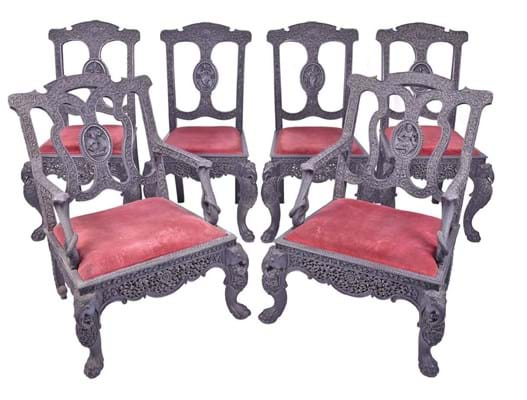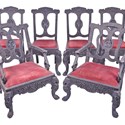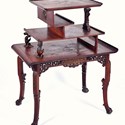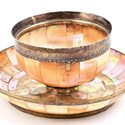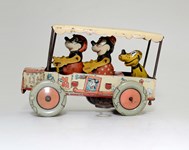In the book Furniture from British India and Ceylon, Dr Amin Jaffer’s chapter on 17th century furniture from the Coromandel Coast begins with the line: “No other group of Indo-European furniture has been as misunderstood as carved ebony furniture made in India, Ceylon and the Dutch East Indies in the second half of the 17th century.”
For most of the Georgian and Victorian era these distinctive seats and tables were thought to be early English furniture – a misconception fuelled by Horace Walpole (1717-97), who collected ebony furniture for his Richmond Gothic Revival house, Strawberry Hill.
As reported last week (ATG No 2307, where two were pictured), the harlequin set of six chairs offered in Berkshire was quite possibly among the well-known collection of Coromandel Coast furniture acquired by the Marquis of Westminster for the family seat, Eaton Hall.
Huge prices were paid for these in the 19th century (one pair cost Westminster £58 16s in 1842). However, when the house was sold in 1960 and the Eaton Hall furniture dispersed at the Montpelier Galleries (later Bonhams), the chairs were sold for about £2 each.
This group of three pairs were from the estate of Anthony Tooth, a relative of the well-known dealing family. The successful bid of £26,000 from the London trade was a decent one: as part of Christie’s Arts of India sale in May this year a single pair sold at £5000.
Back at Dawson’s, a set of six Anglo-Indian or Sri Lankan chairs from the British colonial period (above) sold at £6400.
Made in the latter years of the 19th century, these were carved to the backs with a riot of fruiting and flowering foliage and various Hindu deities and to the swept forelegs with elephant’s masks and paw feet. The arms were formed by rearing cobras worked in the round.
Two Indo-Portuguese mother-of-pearl vessels – a 4in (10.5cm) bowl and a 6½in (16cm) shallow dish c.1700 – were gifted to the Bourne End vendor during a trip to Australia in the 1960s. Both structurally sound with old repairs, they were of the familiar type associated with Gurjurat, India’s westernmost state that was the production centre for a whole range of mother-of-pearl articles in the 16th and 17th centuries.
A number of these treasured pieces were later mounted in Europe, such as a silver-gilt mounted basin in the Victoria and Albert Museum, bearing London marks for 1621.
The bowl offered here had a white metal rim inscribed with ecclesiastical Latin script: Memoriae Christianitatis Elizabethae Kighley Consngviniae Gvilielmvs Wheller Hervevs Testis Indignvs Consegravit Dittoniee In Comitatv Svrrie Septembr 1625.
That translates loosely as: In Christian memory of Elizabeth Kighley, wife of William Wheller. Unworthy witness has consecrated [the marriage] at Ditton in the county of Surrey September 1625. An English silver mount of this date would make it quite a rarity.
Following interest from prominent silver dealers and phone lines covering India, Portugal, London and New York, the two pieces sold together for £22,000 (estimate £2000-3000).
Tribal hits
It is indicative of the wider market that the noteworthy sums in this sale were paid for objects that came from foreign shores.
A quartet of Polynesian clubs from the Tooth estate were thought to be 19th century trade goods made in an era when traditional tools of stone, shell or shark and rodent teeth were replaced by metal blades.
A 19th century incised Tongan war club (apa-apai) carved from ironwood was the top performer at £8000. Its tapering ‘crocodile head’ form sits on top of a shaft incised with panels of zigzags with a terminal similarly carved with crescent moons and stylised fish.
Sold at £1700 was a club of tapering bladed form with a twin-pronged blade decorated with incised crosses. Bids of £600 and £700 were taken for a Maori chief’s/fighting staff (taiaha) and a typical Austral Islands paddle, with intricate chip-carved decoration across its large leaf-shaped blade.
French flavour
A trio of late 19th century French walnut and ormolu occasional furniture made by Gabriel Viardot (1830-1906) came from a local source. A (1.79m high x 96cm wide) cabinet embellished across its shelves and drawers with intertwining bronze dragons was signed twice: to the top compartment with 12 Japanese characters and to the opposite side G Viardot and the date 1887.
Two years earlier Viardot had received the Légion d’honneur for ‘Chinese-Japanese genre’ furniture with his workshop at the time supporting close to 100 staff. The cabinet sold much as expected at £5000 to a UK private buyer. Unsigned but in the same style was a four-tier display stand and a bank of display shelves sold at £850 and £900 respectively.


